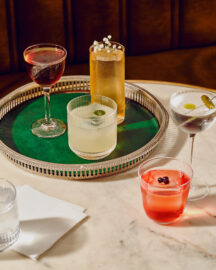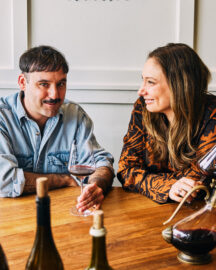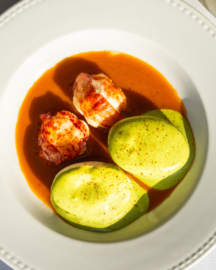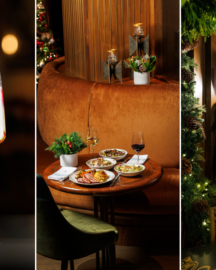The Nature of Wine

Wine growers chasing the holy grail of sustainability find that all roads don’t lead to organics.
ORGANIC FARMING is presented as the gold standard in eco-friendly wine production. The consumer message is simple: Eliminate synthetic pesticides and systemic products, such as the sprays that enter a plant’s vascular system, and the environment wins. But layer in the broader concept of sustainability — being able to continue what you’re doing now without compromising the needs of
future generations — and it’s not so clear.
Is an organic approach — or, in its more extreme form, biodynamic — really the most sustainable choice for wine-growing? More complex and nuanced arguments leave much room for doubt. But applying new technologies and dusting off old ones may just put the sustainability back into organics.
Current conventional thinking distills agriculture into an industrial process with a demand to increase efficiencies, usually through chemical inputs. No one doubts that this is unsustainable. As winemaking and viticultural consultants as well as long-time proponents of organic/biodynamic wine-growing, Ann Sperling and Peter Gamble point out that “synthetic pesticides are not a long-term answer.” They cite the obvious problem of their increasing costs and reduced effectiveness through overuse and that “pests of all kinds are developing resistance.” Like an arms race, the argument goes, greater resistance leads to higher doses of more potent chemicals, which leads to greater resistance.
But the thing with organics is that one simply replaces synthetic products with naturally occurring pesticides, like copper, a natural fungicide permitted under organic farming. Despite being “natural,” however, copper is a poison, a heavy metal that accumulates in soils over time and renders them toxic and lifeless.
Matthieu Beauchemin of Domaine du Nival, southeast of Montreal, thinks that organics should be a baseline for sustainability but is, by no means, an end in itself. “We’re erring as growers if we simply adopt a conventional way of farming with organic products instead of synthetic chemicals. The goal here should be sustainability, not just organics.” Sustainable farming needs to change this way of thinking and find a more holistic solution.
In some parts of the world, growing grapes in “conventional organics” is probably very close to sustainable. “Many challenges in vineyards are linked to high humidity and rainfall,” says Rhys Pender, a partner in Little Farm Winery, in the South Okanagan’s Similkameen Valley. Humid- ity and rain increase disease pressure, especially mildews, and thus more sprays are needed to control their spread. But in semi-arid places, like the Mediterranean and the South Okanagan, growing grapes organically is a no-brainer, according to Pender. “Really, in this part of the world, there is no reason to not be organic unless you’re either lazy and want the quick fix of dangerous chemicals, or you’re too worried about the look of a few weeds.”
But in most of the rest of Canadian wine country, from Vancouver Island to Nova Scotia, where spraying is required frequently, the sustainability of conventional organics is questionable. Michelle Bouffard — founder of Tasting Climate Change, an international symposium aimed at exploring sustainable solutions for the wine industry — has studied sustainability across the globe and she looks critically at the correlation between organics/biodynamics and sustainability.
“Sustainable wine-growing is a broader concept,” Bouffard notes. “It should include important factors, such as measuring carbon footprint, water management, soil health, biodiversity, and the
use of cover crops, just to name a few.” In a region where rain is a constant threat, organic viticulture might not be the best option. “Multiple copper treatments that poison the soil and burn [tractor] fuel is not a sustainable choice,” she says.
Zaché Hall of Domaine de L’Espiègle, in Dunham, Quebec, offers a case in point. Hall, who has been farming organically from the start in this rainy, humid region, tells me the approach is not sustainable. “We can’t still be doing this in 100 years,” he says, referring to the amount of copper needed to treat mildew and the high number of tractor trips through the vineyard.
Simon Naud of nearby Vignoble de la Bauge, in Brigham, is similarly circumspect, questioning the best route to sustainability. “It’s important to continue to reflect on the direct effect of organic cultivation on ecosystems and biodiversity. It can have long-term harmful effects.” He too cites problems related to increased diesel consumption and increased soil toxicity, as well as the soil compaction resulting from frequent tractor passes to spray and weed mechanically, which literally suffocates vines over time.
Paul Speck of Henry of Pelham in Ontario’s Niagara Peninsula is one of the founding members of Sustainable Winegrowing Ontario, whose mission is to “cultivate awareness, commitment and leadership in sustainable wine-growing practices in Ontario.” Speck has clear views on sustain- ability — and that includes economics.
“Our experience, since 1984, tells us that organic vineyards are not com- mercially viable in Ontario.” Speck has seen many grape growers and wineries convert to organic farming over the years, only to return to what he describes, telling- ly, as a sustainable wine-growing model. “Sustainable farming is not just the responsibility to look after the land. It must also be commercially responsible. You cannot have a sustainable business that doesn’t satisfy both needs.”
Moreover, Speck believes that sustainable models have environmental advantages as well. “There are many studies that show the carbon footprint of organics is significantly higher than sustainable farming at the commercial level.”TECHNOLOGY TO THE RESCUE
Yet, rapidly evolving technologies may be shifting the balance back to organics, even in challenging climates. Harald Thiel of Hidden Bench in the Niagara Peninsula — an organically and sustainably certified winery — points out that “every major tractor producer is now producing a first-generation electric tractor which will eventually reduce or eliminate hydrocarbon emissions.”
Sperling and Gamble also tell me that adopting organics has become much easier, and more sustainable, in recent times, crediting advancements in technologies coupled with the growing body of experience accumulated by the rising number of organic/biodynamic producers worldwide. “Opinions about organic/biodynamic viticulture from just five years ago are now wildly outdated,” says Gamble.
Sperling and Gamble point, for example, to the development of stable “biologicals,” micro-organisms used in foliar sprays on leaves to resist mildews, and “immune activators,” which trigger the plant’s own immune response to diseases. “They are game changers,” notes Gamble. The duo also directly addresses the major criticism of organics/biodynamics, namely the overuse of copper, stating that this too is outdated. “The recent development of sa- ponified copper products have reduced the necessary amount of copper by 20 times — a revolutionary technological achievement for organic viticulture.”OTHER ROUTES TO SUSTAINABILITY
Other answers lie in following not just evolving technologies, but also dusting off ancient ones. Back in Quebec, Hall is searching for ways to increase sustainability without resorting to synthetics, such as increasing the overall health of soils and plant resilience through composting, treating mildews with natural anti-fungal teas, and tracking the life cycles of both friends and foes in the vineyard to achieve a natural balance.
For his part, Naud is trialling multiple holistic regenerative approaches that he believes will prove more sustainable than conventional organics, such as agroforestry, which incorporates trees and shrubs into vineyard ecosystems to create a more biodiverse environment, which in turn results in more efficient use of resources (nutrients, light and water), disease resistance and better ecosystem balance.
Naud is also a big proponent of grazing animals in the vineyard, a practice encouraged in biodynamic farming. “When I suggest this to other growers, they complain that it’s too complicated,” he says. “But I can prove to them now how readily it can be done.” He then shows me the simple paddock system he has developed. Natural weed control, fertilization, reduced soil compaction, targeted leaf removal, pest control — the benefits of incorporating animals are many.
Yet perhaps the most obvious step towards sustainability, Naud thinks — which has not been mentioned so far — is the choice of grape varieties planted to begin with.
“Why not plant hybrid vines that are better adapted to our climate and disease pressures?” he asks. This might be crossings between European vitis vinifera species with native North American species. “Or, better yet, the new generations of PIWIs?” He’s referring to newly available fungus-resistant grapes that require little or no spraying. Questions about wine quality and consumer acceptance are something else altogether.
In the end, the routes to sustainability will be many, and there’s little doubt that organic and biodynamic approaches will be included in the mix. The wine industry is working diligently on its green credentials, and the evolution towards a truly sustainable future looks shiny green.
— By John Szabo, MS
Photography by John Szabo and Henry Of Pelham.






